Animals
Understanding Mammals: A Comprehensive Guide On The Diversity, List & Characteristics Of Mammals

Did you know that there are over 6,400 known species of mammals on Earth? From the tiny bumblebee bat, weighing just 2 grams, to the massive blue whale, which can grow up to 98 feet long and weigh over 200 tons, mammals come in a staggering array of shapes and sizes.
Whether you’re fascinated by their unique adaptations, curious about their diverse habitats, or eager to explore the intricacies of mammal classification, this comprehensive guide will provide you with a wealth of knowledge about these incredible creatures. Join us as we embark on a journey to understand the diversity, list, and characteristics of mammals.
From the smallest rodent scurrying through the forest to the majestic predators ruling the savannah, mammals play vital roles in ecosystems around the world. Let’s dive in and discover the wonders of the mammalian world!
Key Takeaways:
- Mammals encompass a vast range of species, from the smallest bats to the largest whales.
- Their diverse adaptations and characteristics make them unique among animals.
- Understanding mammal classification and diversity is essential for comprehending their role in ecosystems.
- Mammals exhibit a wide variety of behaviors, habitats, and anatomical features.
- Conservation efforts are crucial for protecting the incredible diversity of mammalian species.
What Defines a Mammal?
To truly understand what defines a mammal, it is important to explore their unique features, evolutionary history, and diverse classification. From the distinctive characteristic of mammary glands to the fascinating variety of mammal species, these remarkable creatures continue to captivate scientists and nature enthusiasts alike.
Understanding the Features of Mammals
One key feature that sets mammals apart is their ability to nurse their young with milk produced by their mammary glands. These specialized glands are a defining characteristic of mammals and have played a crucial role in their evolution and survival. Additionally, mammals have a unique skeletal structure, warm-blooded metabolism, and a range of adaptations that allow them to thrive in various habitats.
The Evolutionary History of Mammals
Mammals have a rich evolutionary history that spans millions of years. They are believed to have descended from reptilian ancestors and have undergone significant adaptations over time. Through the process of evolution, mammals have developed diverse anatomical, physiological, and behavioral traits that have enabled them to occupy a wide range of ecological niches.
Importance of Mammary Glands in Mammals
The presence of mammary glands in mammals is a defining characteristic of the group. These glands produce milk, a nutrient-rich substance that provides vital nutrition to mammal offspring during their early stages of life. This unique form of feeding has contributed to the success and survival of mammalian species, allowing for the nurturing and protection of their young.
Types of Mammals
When exploring the world of mammals, it becomes clear that they come in various shapes and forms. Mammals can be broadly classified into three main groups: placental mammals, monotremes, and marsupials. Each group exhibits distinct reproductive strategies and unique adaptations that have allowed them to thrive in different environments.
Exploring Placental Mammals
Placental mammals, the largest and most diverse group of mammals, give birth to live young who have fully developed internally before birth. These mammals have a placenta, a specialized organ that allows for the exchange of nutrients and waste between the mother and the developing fetus. Placental mammals include familiar creatures such as dogs, cats, whales, and humans.
Insight Into Monotremes
Monotremes are an extraordinary group of mammals that lay eggs rather than giving birth to live young. They are considered to be the most primitive group of mammals and include the platypus and echidna. Monotremes have a unique reproductive system, combining reptilian and mammalian characteristics.
Discovering Marsupials
Marsupials are another fascinating group of mammals that are characterized by their pouches, in which they carry and nurture their undeveloped young. These pouches provide a safe environment for the marsupial offspring to grow and develop after being born in an embryonic state. Well-known examples of marsupials include kangaroos, koalas, and opossums.
Characteristics Of Mammals
In this section, we will explore the fascinating characteristics that make mammals unique. From their ability to produce milk to their specialized anatomy, mammals have evolved a wide range of adaptations that enable them to thrive in various environments.
Able to Produce Milk
One of the defining features of mammals is their ability to produce milk. Female mammals, known as mothers, possess mammary glands that secrete milk to nourish their young. This adaptation ensures the survival and growth of offspring, providing them with essential nutrients and antibodies.
Diaphragm
Mammals have a diaphragm, a muscular organ that plays a crucial role in breathing. It contracts and relaxes, allowing for the expansion and contraction of the lungs, enabling mammals to inhale and exhale air efficiently.
Endothermy
Endothermy is a characteristic unique to mammals. It refers to the ability of mammals to regulate their own body temperature independently of the environment. This adaptation allows mammals to thrive in a wide range of habitats, from scorching deserts to freezing polar regions.
Four-Chambered Heart
Mammals have a four-chambered heart, consisting of two atria and two ventricles. This advanced cardiovascular system ensures efficient circulation of oxygenated blood throughout the body, delivering oxygen and nutrients to vital organs and tissues.
Hair or Fur
An important characteristic of mammals is the presence of hair or fur on their bodies. Hair provides insulation, protects the skin, and plays a role in sensory perception. It can vary in texture, color, and thickness, serving various purposes depending on the species and environment.
Internal Fertilization
Mammals reproduce through internal fertilization, where the male’s sperm fertilizes the female’s eggs inside the body. This adaptation allows for better protection, development, and nurturing of the offspring until birth.
Mammary Glands
Mammary glands are unique to mammals and are responsible for the production of milk. These specialized glands develop during pregnancy and lactation, enabling the nourishment of offspring. The structure and number of mammary glands vary among different mammal species.
Neocortex
The neocortex is a part of the brain that is highly developed in mammals. It is responsible for complex cognitive functions, including perception, consciousness, language, and reasoning. The size and complexity of the neocortex correlate with the intelligence and adaptability of mammals.
Single-Boned Lower Jaw
Mammals have a single-boned lower jaw, known as the mandible. This structure allows for efficient chewing and grinding of food, facilitating the digestive process. The mandible is an essential adaptation that enables mammals to consume a diverse range of diets.
Specialized Teeth
The teeth of mammals are highly specialized, adapted to their specific dietary needs. Mammals exhibit various types of teeth, including incisors, canines, premolars, and molars, each serving a specific role in capturing, tearing, cutting, crushing, or grinding food.
Three Bones in the Middle Ear
Mammals have three bones in the middle ear, known as the ossicles: the malleus, incus, and stapes. These bones transmit sound vibrations from the eardrum to the cochlea, allowing mammals to hear a wide range of sound frequencies with remarkable precision.
Viviparity
Most mammals exhibit viviparity, a mode of reproduction where the embryos develop within the mother’s body and are nourished through a placenta. This adaptation enables mammals to give birth to live young, ensuring better maternal care and higher survival rates.
Types Of Mammals
In the fascinating world of mammals, there is a remarkable diversity based on their unique reproductive systems. Mammals can be categorized into different types, each with its own distinct characteristics. Let’s explore these types and uncover the wonders of mammal reproduction.
Types Of Mammals By Reproduction System
Mammals can be classified into three main groups based on their reproductive methods:
- Monotremes: These intriguing creatures are known as the oddballs of reproduction. Monotremes are the only mammals that lay eggs instead of giving birth to live young. This small group includes the platypus and echidna, both native to Australia and parts of New Guinea. Monotremes possess unique reproductive organs and have a fascinating blend of traits from reptiles and mammals.
- Marsupials: Marsupials are renowned for their distinctive reproductive strategy. After a relatively short gestation period, the underdeveloped young are born, and they continue their development within a special pouch. Iconic marsupials include kangaroos, wallabies, and koalas. The marsupial pouch provides a nurturing environment for the young, allowing them to grow and develop until they are ready to explore the world.
- Placental Mammals: The majority of mammal species fall into this category. Placental mammals, including humans, have a more complex reproductive system. They nurture their young within the mother’s womb through a specialized organ called the placenta. This allows the developing offspring to receive nourishment and oxygen from the mother’s bloodstream. Placental mammals exhibit a wide range of diversity, from tiny mice to magnificent elephants.

Monotremes: The Oddballs Of Reproduction
Monotremes are a remarkable group of mammals with a unique reproductive strategy. They lay eggs, a rare phenomenon among mammals. Monotremes possess cloacas, a single opening for both reproduction and waste elimination. Male monotremes have a spur on their hind legs that secretes venom, which is used during competition and defense.
“Monotremes represent an extraordinary example of reproductive adaptation in the animal kingdom.” – Dr. Jane Dawson, mammalogist
Monotremes have a relatively short gestation period before laying eggs. The eggs are incubated outside the mother’s body in a nest or burrow. After hatching, the young monotremes, called puggles, are nurtured by the mother, who provides them with milk through mammary glands. This combination of egg-laying and milk production is a truly unique adaptation found only in monotremes.
The two main species of monotremes are the platypus and the echidna. The platypus is well-known for its duck-like bill, webbed feet, and ability to detect prey through electroreception. The echidna, also known as the spiny anteater, has a spiky coat and a long snout for feeding on insects and ants.
Monotremes are living relics from an ancient lineage of mammals, representing a fascinating aspect of evolutionary biology. Their reproductive strategy continues to captivate scientists and ignite curiosity about the diversity of life on Earth.
Marsupials: The Ultimate Pouch Crew
In this section, we explore the fascinating world of marsupials, a unique group of mammals known for their distinctive reproductive system and pouches. Marsupials are characterized by their reproductive adaptations and nurturing behaviors, making them truly remarkable creatures.
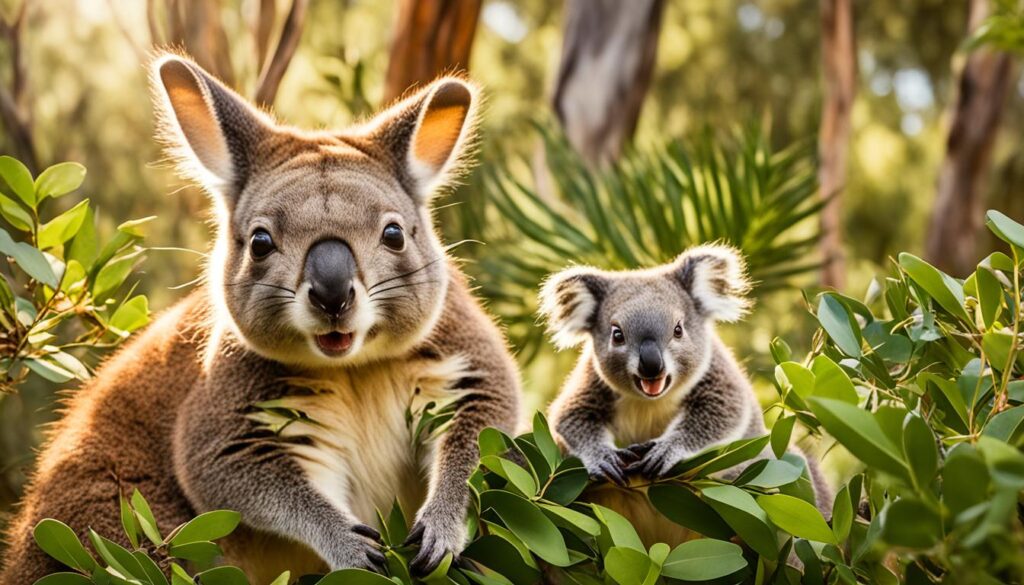
Unique Characteristics of Marsupials
Marsupials possess a range of distinct characteristics that set them apart from other mammals. One of the most prominent features is the marsupial pouch, where the young, called joeys, complete their development after birth. The pouch provides a safe environment for the vulnerable joeys, enabling their growth and protection.
Additionally, marsupials have a specialized reproductive system where the young are born in an undeveloped state. After birth, the newborns crawl into their mother’s pouch, where they attach to a teat and continue their growth. This adaptive reproductive behavior allows marsupials to thrive in various environments and adapt to changing ecological conditions.
Behavior of Marsupials
Marsupials display a diverse range of behaviors that are specific to their individual species and their habitats. Some marsupials, such as kangaroos and wallabies, are known for their incredible jumping abilities, which help them navigate their environments and escape from predators.
Other marsupials, like koalas and wombats, are adapted for a more sedentary lifestyle and are expert climbers or burrowers. These behaviors enable them to find food sources and seek shelter in their natural habitats.
Placental Mammals: The Baby Belly Champions
Placental mammals, on the other hand, have their own unique adaptations when it comes to reproduction. Unlike marsupials, placental mammals nurture their young inside the womb through the placenta, a specialized organ that facilitates the exchange of nutrients and waste between the mother and offspring.
Adaptations of Placental Mammals
Placental mammals have evolved a wide range of adaptations that allow them to thrive in various environments. From the ability to live in terrestrial, aquatic, and aerial habitats to their diverse feeding habits, placental mammals have developed remarkable adaptations to ensure survival.
These adaptations include features such as specialized teeth for different feeding habits, efficient digestion systems, and various forms of locomotion. Additionally, placental mammals have developed sophisticated sensory systems, including acute hearing and vision, to navigate their surroundings and find food sources.
Reproduction in Placental Mammals
Placental mammals reproduce through internal fertilization, where the sperm fertilizes the egg within the female’s reproductive tract. The fertilized egg then develops into an embryo that attaches to the uterus wall, forming the placenta.
During gestation, the placenta supplies the developing young with oxygen, nutrients, and removes waste products. This method of reproduction allows placental mammals to have longer gestation periods and give birth to well-developed young.
Table: A Comparison of Marsupials and Placental Mammals
| Characteristic | Marsupials | Placental Mammals |
|---|---|---|
| Reproductive System | Young develop in mother’s pouch | Young develop in the womb through the placenta |
| Behavior | Variable behaviors depending on species; jumping, climbing, burrowing | Diverse range of behaviors; adapted to different habitats and food sources |
| Adaptations | Pouch for nurturing young; specialized reproductive system | Diverse adaptations for various habitats and feeding habits |
List Of Mammals
This section presents a comprehensive list of mammals, showcasing the remarkable diversity within the mammalian kingdom. Mammals encompass a vast array of species, ranging from the small and elusive to the large and majestic. From the iconic lion to the minutely-detailed pygmy shrew, the world of mammals is a testament to the wonders of evolution and adaptation.
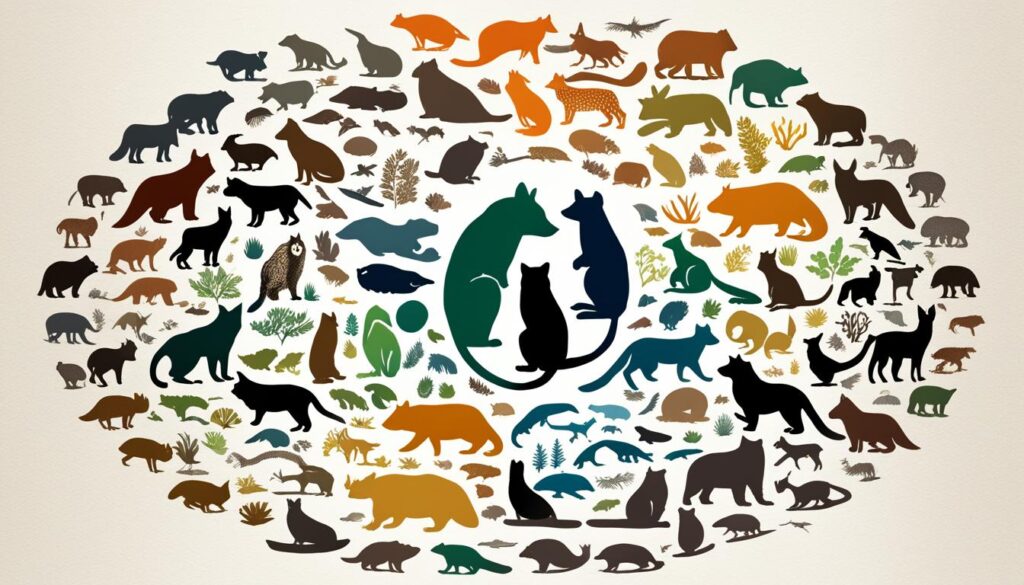
Threats And Conservation Of Mammals
This section discusses the various threats that mammals face and highlights the importance of conservation efforts in protecting these vulnerable creatures. Mammals play a crucial role in maintaining the balance of ecosystems, and their conservation is essential for preserving biodiversity.
Indirect Threats
Mammals are susceptible to indirect threats that result from human activities and environmental changes. Habitat loss is a significant concern, as deforestation, urbanization, and agricultural expansion continue to encroach upon natural habitats. The destruction of forests, wetlands, and grasslands deprives mammals of their homes and sources of food.

Climate change poses another dire threat to mammal populations. Rising temperatures, extreme weather events, and altered precipitation patterns disrupt ecosystems and impact the availability of food and water. This results in habitat degradation and reduced reproduction rates for many mammal species.
Direct Threats
In addition to indirect threats, mammals also face direct threats from human activities. Hunting and poaching for fur, meat, and body parts have decimated mammal populations globally. Unsustainable hunting practices and the illegal wildlife trade contribute to the decline of numerous species, pushing them towards the brink of extinction.
Endangered mammals also fall victim to illegal wildlife trafficking, which poses a severe threat to their survival. The demand for exotic pets, traditional medicine ingredients, and rare animal products drives the illegal trade, leading to the exploitation and depletion of vulnerable mammal species.
Mammal conservation plays a pivotal role in combating these threats and safeguarding endangered species. It involves implementing measures to protect habitats, regulating hunting practices, raising awareness about the importance of conservation, and enforcing legislation to combat illegal wildlife trade.
| Threats | Impact |
|---|---|
| Habitat loss | Displacement, reduced food availability |
| Climate change | Habitat degradation, reduced reproduction rates |
| Hunting and poaching | Declining populations, extinction risk |
| Illegal wildlife trade | Exploitation, depletion of populations |
Table: Threats to Mammals and Their Impacts.
Conservation Acts
Conservation acts play a crucial role in protecting endangered species and preserving the delicate balance of ecosystems. These acts provide legal frameworks and guidelines for managem
enting and conserving mammalian species, ensuring their survival and promoting biodiversity. One prominent legislation in the United States is the Endangered Species Act. Enacted in 1973, this act aims to prevent the extinction of threatened and endangered species, including mammals, by providing protection and implementing recovery plans.
Internationally, there are various conservation efforts and treaties dedicated to wildlife protection, such as the Convention on International Trade in Endangered Species of Wild Fauna and Flora (CITES). CITES regulates international trade in endangered species and provides a framework to combat wildlife trafficking.
Additionally, organizations like the International Union for Conservation of Nature (IUCN) facilitate global conservation initiatives. Through assessments, policy advocacy, and knowledge sharing, the IUCN leads efforts to protect and conserve mammalian species and their habitats worldwide.
By implementing and enforcing wildlife protection laws, conservation acts contribute to the preservation of mammalian species and the conservation of their natural habitats.
Mammals in the Wild
In their natural habitats, mammals have evolved and adapted to thrive in diverse environments. From the depths of the ocean to the heart of the rainforest, these remarkable creatures have developed unique characteristics and behaviors to survive and thrive. This section will explore the fascinating lives of mammals in the wild, focusing on the adaptations of marine mammals, the distinctive traits of terrestrial mammals, and the special behaviors of arboreal mammals.
Adaptations of Marine Mammals
Marine mammals are a diverse group that includes whales, dolphins, seals, and sea lions. These incredible creatures have evolved numerous adaptations to thrive in water. Their streamlined bodies and torpedo-like shapes enable efficient swimming and diving, allowing them to hunt for food and evade predators. Marine mammals also have specialized flippers or fins that aid in locomotion and navigation. Blubber, a thick layer of fat beneath their skin, helps provide insulation and buoyancy, allowing them to maintain their body temperature in cold water. Additionally, these mammals have developed unique respiratory systems that allow them to hold their breath for extended periods while diving deep underwater. The adaptations of marine mammals have enabled them to become well-adapted and highly successful inhabitants of the world’s oceans.
Unique Characteristics of Terrestrial Mammals
Terrestrial mammals are the most familiar group of mammals as they live on land, including a vast diversity of species such as elephants, lions, and horses. These mammals have evolved numerous adaptations to thrive in various terrestrial habitats. One of the key characteristics of terrestrial mammals is their ability to walk or run on land using specialized limbs. Some species have evolved powerful legs for running, while others have developed adaptations for climbing, burrowing, or digging. Terrestrial mammals also have a wide range of dentition, with different types of teeth specialized for various diets such as herbivory, carnivory, or omnivory. Additionally, many terrestrial mammals have evolved acute senses, such as sharp eyesight or keen sense of smell, to detect predators, find food, or communicate with others. With their remarkable adaptations, terrestrial mammals have carved out niches in diverse ecosystems around the world.
Special Traits of Arboreal Mammals
Arboreal mammals are a group of mammals that have adapted to life in trees. This group includes primates, such as monkeys and apes, as well as a variety of other mammalian species. Arboreal mammals have developed unique traits to navigate and thrive in the treetops. They possess grasping hands or feet with opposable thumbs or toes, allowing them to grip onto branches and move with agility. Some arboreal mammals, such as squirrels, have evolved specialized adaptations like bushy tails that aid in balance and provide stability while leaping between branches. These mammals also have keen eyesight and acute hearing to detect potential threats or opportunities for food. With their extraordinary adaptations, arboreal mammals have conquered the complex and challenging environment of the trees.
Importance of Mammals in Ecosystems
Mammals play a crucial role in maintaining the balance and functioning of ecosystems. They contribute to various ecological processes, including nutrient cycling, seed dispersal, and pollination. Understanding the ecosystem roles of different types of mammals, such as herbivorous, predatory, and omnivorous mammals, is essential for comprehending the complexities of mammal ecology.
Role of Herbivorous Mammals in the Food Chain
Herbivorous mammals, also known as grazers or browsers, have a significant impact on the food chain. They consume plant material, such as leaves, stems, fruits, and seeds, and influence vegetation dynamics, nutrient cycling, and plant community composition. By regulating plant growth, herbivorous mammals help maintain habitat structure and promote the diversity of plant species. They also serve as a food source for other carnivorous mammals and predators, creating a link in the intricate web of trophic interactions.
Impact of Predatory Mammals on Population Dynamics
Predatory mammals, including wolves, lions, and tigers, play a critical role in regulating prey populations. Their presence helps control the population sizes of herbivorous mammals and prevents overgrazing or overpopulation of certain species. By exerting predation pressure, predatory mammals contribute to maintaining the structure and stability of ecological communities. They also promote behavioral adaptations in prey species, leading to the development of defensive strategies and enhanced survival mechanisms.
Contribution of Omnivorous Mammals to Biodiversity
Omnivorous mammals, such as bears and raccoons, occupy a unique niche in ecosystems due to their ability to consume both plant and animal matter. Their dietary versatility allows them to exploit various food resources, contributing to the sustainability and diversity of ecosystems. As omnivores, they can influence seed dispersal by consuming fruits and depositing seeds in different locations. Additionally, their feeding habits can indirectly shape plant communities and influence the abundance and distribution of other animal species.
The intricate relationships between herbivorous, predatory, and omnivorous mammals highlight the interconnectedness of species within ecosystems. Understanding the roles that mammals play is vital for conservation efforts, as any disruption to their populations can have far-reaching consequences for the entire ecosystem. By protecting mammal populations and safeguarding their habitats, we can preserve the delicate balance of nature and ensure the sustainability of our planet’s ecosystems.
Different Types Of Mammals By Groups
Section 11 explores the diverse world of mammals, categorized into different groups based on their unique characteristics and behaviors. This section focuses on various mammal groups, including monotremes, marsupials, placental mammals, primates, rodents, bats, cetaceans, and ungulates. Each group exhibits fascinating adaptations, distinct classifications, and remarkable anatomy.
Monotremes: The Eccentric Egg Layers
Monotremes are a fascinating group of mammals that lay eggs, making them truly eccentric in the mammalian world. This group includes iconic species such as the platypus and echidna. Monotremes have unique reproductive systems and exhibit a combination of reptilian and mammalian traits.
Marsupials: The Pouch Bearers
Marsupials are known for their remarkable adaptation of carrying their young in pouches. This group includes well-known species such as kangaroos, koalas, and opossums. Marsupials have a distinct reproductive system and exhibit a wide range of behaviors and characteristics specific to their habitats.
Placental Mammals: The Womb Nurturers
Placental mammals, the largest group of mammals, nurture their young in the womb through a specialized placenta. This group encompasses diverse species, including humans, dogs, cats, elephants, and whales. Placental mammals have evolved various adaptations and display a wide range of behaviors and anatomical features.
Primates: The Intelligent Behaviors
Primates, including humans, monkeys, and apes, are characterized by their highly developed brains and complex social behaviors. These intelligent mammals exhibit diverse adaptations and can be found in various habitats across the globe.
Rodents: The Playful Scavengers
Rodents encompass a vast group of mammals that are known for their continuous-growing front teeth and their ability to gnaw and chew. This group includes species such as mice, rats, squirrels, and beavers. Rodents exhibit playful behavior and have adapted to various environments.
Bats: The Nocturnal Flyers
Bats are the only mammals capable of sustained flight. They have unique adaptations such as echolocation, enabling them to navigate and locate prey in the darkness. Bats play crucial ecological roles as pollinators and insect controllers.
Cetaceans: The Oceanic Virtuosos
Cetaceans, including dolphins, whales, and porpoises, are highly adapted to marine life. These remarkable mammals have evolved streamlined bodies, flippers, and blowholes to thrive in aquatic environments. Cetaceans have intricate communication systems and exhibit complex social structures.
Ungulates: The Mighty Hoofed Beasts
Ungulates are a diverse group of mammals known for their hooves and herbivorous diets. This group includes iconic species such as horses, deer, cows, and elephants. Ungulates have evolved specialized adaptations to survive in various habitats, and their anatomical features vary based on the species.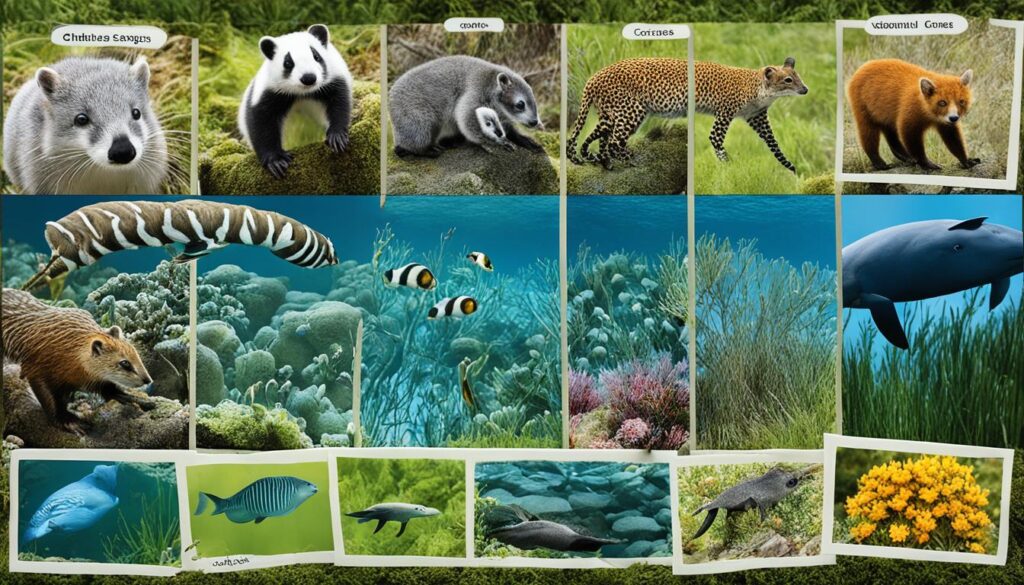
| Mammal Group | Key Features | Behaviors | Adaptations | Anatomy |
|---|---|---|---|---|
| Monotremes | Unique reproductive systems | Egg-laying behavior | Combination of reptilian and mammalian traits | Varying anatomical structures |
| Marsupials | Pouch-bearing reproductive system | Carrying young in pouches | Diverse adaptations based on habitat | Varying anatomical structures |
| Placental Mammals | Placenta for nurturing young | Diverse range of behaviors | Efficient adaptations for survival | Wide variety of anatomical features |
| Primates | Highly developed brains | Complex social behaviors | Opposable thumbs, enhanced intelligence | Diverse anatomical characteristics |
| Rodents | Continuous-growing front teeth | Playful behavior, scavenging | Gnawing adaptations, efficient digestion | Diverse sizes and body structures |
| Bats | Echolocation abilities | Nocturnal flying behavior | Wings, nocturnal vision | Specialized skeletal structures for flight |
| Cetaceans | Aquatic adaptations | Complex communication, social structures | Streamlined bodies, blowholes | Diverse anatomical features for marine life |
| Ungulates | Herbivorous diet, hoofed feet | Group behavior, migration | Specialized teeth, digestive systems | Varied anatomical structures based on habitat |
Conclusion
In conclusion, this comprehensive guide has provided a deep dive into the world of mammals, highlighting their diversity, characteristics, and importance in ecosystems. From their unique reproductive systems and adaptations to their crucial roles in food chains, mammals are truly remarkable creatures.
Throughout this guide, we have explored the defining features of mammals, such as their ability to produce milk, possess a diaphragm, and regulate their body temperature through endothermy. We have also examined their specialized anatomical traits, including a four-chambered heart, hair or fur, and mammary glands, which differentiate them from other animal groups.
Moreover, we have categorized mammals based on their reproductive systems, exploring the eccentric egg-laying monotremes, the pouch-bearing marsupials, and the womb-nurturing placental mammals. We have also delved into specific groups like primates, rodents, bats, cetaceans, and ungulates, each with their own unique behaviors and adaptations.
It is evident that mammals play a vital role in maintaining the delicate balance of ecosystems. Herbivorous mammals contribute to the food chain, while predatory mammals regulate population dynamics. Additionally, omnivorous mammals contribute to biodiversity by interacting with various plant and animal species.
In light of this knowledge, it is crucial to recognize the importance of conservation efforts to protect mammals and their habitats. By understanding and appreciating these fascinating creatures, we can work towards safeguarding their future and preserving the rich biodiversity of our planet.
FAQ
What is a mammal?
How many species of mammals are there?
What are the different types of mammals?
Why are mammals important?
What are the threats to mammal populations?
What conservation efforts are in place to protect mammals?
What are some examples of mammalian habitats?
What are some unique characteristics of primates?
What are some adaptations of marine mammals?
How do mammals reproduce?
What are some unique characteristics of bats?
How are mammals classified?
As our Editor-in-Chief, James plays a pivotal role in ensuring the quality and integrity of our content. With a keen eye for detail and a passion for storytelling, James oversees the editorial process here at A Place for Animals. With years of experience in content editing, James ensures that every piece of content meets our high standards of accuracy and clarity. Under James’ guidance, you can rest assured that the content you read is informative and impeccably crafted.
Animals
Discover ABC Siberian Cattery: 7 Essential Facts
Peek into the world of ABC Siberian Cattery, where premium quality Siberian forest cats await – a purrfect adventure awaits!

In 2010, ABC Siberian Cattery was established to breed quality Siberian forest cats. They maintain high breeding standards, offering hypoallergenic TICA certified cats, and even collaborated with National Geographic. Neva Masquerade, Traditional Siberian, and Color-point Siberian breeds are available, known for being hypoallergenic. Their cats undergo vet-approved care practices with regular health check-ups, vaccinations, and grooming. The adoption process includes a detailed application, personal conversations, and verification checks. ABC Siberian Cattery values customer satisfaction, provides excellent care, and plans to expand their breeding program. Discover more about ABC Siberian Cattery's exceptional standards and future developments.
Key Takeaways
- Established in 2010 with high breeding standards.
- Offers Neva Masquerade, Traditional, Color-point Siberian breeds.
- Focus on hypo-allergenic TICA certified cats.
- Emphasizes vet-approved health and care practices.
- Known for exceptional customer service and transparency.
History of ABC Siberian Cattery
Established in 2010, I founded ABC Siberian Cattery with a vision to breed high-quality Siberian forest cats. Our journey began with a deep passion for Siberian cats and a dedication to upholding the highest standards in breeding. Over the years, we've meticulously refined our techniques to produce hypo-allergenic Siberian cats that are TICA certified.
Our website uses a strict Privacy Policy to guarantee the safety of our customers' data. At ABC Siberian Cattery, we take pride in our commitment to excellence, reflected in our partnership with National Geographic for a feature on our breeding practices. Our history is a proof of our unwavering dedication to specialized breeding practices and exceptional care for our feline companions.
Breeds Available at ABC Siberian Cattery

At ABC Siberian Cattery, we offer a variety of Siberian forest cat breeds for adoption. These breeds are known for their hypo-allergenic qualities, making them popular choices for families with allergies.
Visit our cattery to find the perfect Siberian forest cat breed that suits your preferences and lifestyle.
Available Breeds
Regularly, ABC Siberian Cattery introduces a variety of Siberian forest cat breeds for adoption, each meticulously raised with care and attention to guarantee their health and well-being.
| Neva Masquerade | Traditional Siberian | Color-point Siberian |
|---|---|---|
| Hypo-allergenic | Purebred | Unique color patterns |
| Blue eyes | Thick, water-repellent coat | Playful and affectionate |
These breeds at ABC Siberian Cattery offer a mix of hypo-allergenic qualities, unique coat characteristics, and distinct personalities. Whether you're drawn to the striking appearance of the Neva Masquerade, the classic beauty of the traditional Siberian, or the color variations of the color-point Siberian, each cat is thoughtfully bred to bring joy and companionship to your home.
Popular Choices
Among the popular choices available at ABC Siberian Cattery are the Neva Masquerade, Traditional Siberian, and Color-point Siberian breeds, each offering unique qualities that cater to different preferences.
The Neva Masquerade stands out with its stunning blue eyes and color-point markings, adding a touch of elegance to any household.
Traditional Siberian cats boast a thick, water-repellent coat perfect for cold climates, while their playful and affectionate nature makes them wonderful companions.
For those seeking a breed with striking color variations on their ears, paws, and tails, the Color-point Siberian is an excellent choice.
These breeds not only bring beauty but also charm and personality to your home, making them popular picks among cat enthusiasts looking for innovative and exceptional feline companions.
Health and Care Standards

At ABC Siberian Cattery, we implement vet-approved care practices and rigorous health monitoring procedures to guarantee the well-being of our Siberian forest cats.
Our commitment to maintaining high health and care standards involves regular check-ups, vaccinations, and preventative measures to keep our cats healthy and happy.
Vet-Approved Care Practices
Ensuring the health and well-being of our Siberian forest cats, ABC Siberian Cattery diligently follows vet-approved care practices. We prioritize regular veterinary check-ups, vaccinations, and preventative care for all our cats.
Proper grooming, parasite control, and dental care are also essential in maintaining peak health standards for our feline friends. At ABC Siberian Cattery, we provide a clean and safe environment with ample space for exercise and mental stimulation, promoting overall well-being.
Adhering to high care standards, we monitor our cats diligently for any signs of illness or distress, ensuring early intervention when necessary. Your cat's health is our top priority, and we're committed to providing the best care possible to keep them happy and healthy.
Health Monitoring Procedures
In our cattery, maintaining high health and care standards involves strict health monitoring procedures for all our Siberian forest cats. We conduct regular veterinary check-ups and health assessments to guarantee the well-being of our feline friends. This includes vaccinations, parasite control, and early detection of any potential health issues.
Detailed records of each cat's health history are kept, allowing us to provide necessary treatments promptly. At ABC Siberian Cattery, we prioritize preventive care and swift medical attention to uphold peak health for all our cats. By following stringent health monitoring protocols, we aim to guarantee the happiness and longevity of our beloved Siberian forest cats.
Adoption Process and Policies

I aid potential adopters through a thorough application process, interviews, and reference checks to guarantee the best match for our Siberian forest cats. When considering adopting a Siberian forest cat from ABC Siberian Cattery, here are some key points to keep in mind:
- Detailed Application Process: Our adoption process involves filling out a comprehensive application form to help us understand your lifestyle and preferences.
- Personal Conversations: We conduct discussions to make sure that both the adopter and the cat will be a good fit for each other.
- Verification Checks: References are contacted to authenticate the information provided and to ensure the well-being of our cats in their new homes.
We believe in creating lasting and fulfilling relationships between our Siberian forest cats and their new families. Our adoption policies are designed to make the process smooth and successful for both the adopters and our beloved feline friends.
Customer Testimonials and Reviews

Receiving glowing testimonials and reviews, ABC Siberian Cattery stands out for its exceptional customer service and high-quality support. Customers praise the cattery for its dedication to providing excellent care for Siberian forest cats. Reviews consistently highlight the outstanding quality of the cats bred at ABC Siberian Cattery, emphasizing their health and well-being.
Testimonials frequently mention the detailed information provided during the adoption process, showcasing the cattery's commitment to transparency and education. Many customers express satisfaction with the adoption experience, underscoring ABC Siberian Cattery's reputation for excellence in every step of the process.
This positive feedback not only reflects the quality of service but also indicates a high level of customer satisfaction. ABC Siberian Cattery's consistent delivery of exceptional customer support and the premium quality of its Siberian forest cats are key factors contributing to its strong reputation in the industry.
Meet the Team at ABC Siberian Cattery

Comprised of dedicated breeders with a profound love for Siberian forest cats, the team at ABC Siberian Cattery excels in providing exceptional care and support for their feline companions.
- Our team consists of experienced breeders who are passionate about Siberian forest cats.
- We prioritize excellent care, nutrition, and socialization for all our cats.
- Each team member plays an essential role in maintaining the health, well-being, and development of our beloved cats.
At ABC Siberian Cattery, we work together seamlessly to make sure that every cat, including those from litters like Fifi's, receives individualized attention and love. Our collective expertise and unwavering commitment contribute to the high standards and exceptional quality of Siberian cats bred here. We take pride in our innovative approaches to cat care and continuously aim to set new benchmarks in the breeding industry.
Future Plans and Developments

Expanding our breeding program to introduce new bloodlines and enhance genetic diversity is a key focus for ABC Siberian Cattery's future plans and developments. By incorporating advanced health and genetic testing protocols, we aim to ensure the well-being of our future litters.
Additionally, we're diligently working on creating a more interactive online platform to provide potential adopters with the opportunity to engage with our available litters actively. Collaborations with other reputable breeders are in progress to exchange knowledge and enhance our breeding practices.
Moreover, we're exploring options to offer educational resources and guidance to new cat owners, ensuring a seamless adoption experience. Our commitment to innovation and excellence propels us to continuously improve our breeding program, providing healthy and well-adjusted Siberian cats for loving homes.
Stay tuned for exciting updates as we endeavor to elevate our standards and make a positive impact in the feline breeding community.
Frequently Asked Questions
What Are Some Fun Facts About Siberian Cats?
Siberian cats, known for their hypoallergenic coats and ancient Russian origins, display intelligence and loyalty. Their triple coat protects in cold climates. Playful and affectionate, they exhibit dog-like traits, following owners around.
How Fast Can Siberian Cats Run?
Siberian cats can sprint up to 30 miles per hour, showcasing their speed and agility. Their powerful hind legs and wild ancestry contribute to this impressive running ability. Owners should provide space for them to exercise.
What Are the Features of the Siberian Forest Cat?
The Siberian forest cat boasts a hypo-allergenic coat and a robust physique designed for harsh climates. They excel in agility, forming strong bonds with humans and pets alike. Their intelligence fuels playful exploration, making them delightful companions.
When Was the Siberian Cat Discovered?
I stumbled upon the fascinating history of Siberian cats during a late-night browsing session. It was astonishing to learn that the breed has been documented since 1000 AD, making them one of the oldest cat breeds known.
Conclusion
So there you have it, folks! ABC Siberian Cattery is the purrfect place to find your new feline friend.
With a rich history, high-quality care standards, and a team dedicated to the well-being of their cats, you can't go wrong.
Just remember, adopting a cat is a lifelong commitment, so make sure you're ready for the responsibility.
Happy cat hunting!
Dana is our Lead Content Writer, bringing a wealth of knowledge and expertise to our team. With a background deeply rooted in animal studies and a profound love for all creatures, Dana is dedicated to crafting engaging and informative content that resonates with our audience. With Dana at the helm, you can trust that our content is accurate and engaging, catering to the diverse interests of animal enthusiasts everywhere.
Animals
3 Important Facts: False
Astonishing truths about common misconceptions await in '3 Important Facts: False', challenging what you thought you knew.

Swimming after eating doesn't cause cramps, salt doesn't make water boil faster, and MSG won't give you headaches. It's important to know these facts to stay informed. Always wait before swimming after a meal, add salt for taste not speed, and MSG is safe in moderation. Check labels for hidden MSG. Remember these key details for a better understanding of common misconceptions. Explore more facts to expand your knowledge and challenge what you know. Understand the truth behind popular beliefs for a clearer perspective on the world around you. More truths await discovery in the world of myths and misconceptions.
Key Takeaways
- Milk does not increase mucus production in the body.
- Alcohol does not kill brain cells as commonly believed.
- Caffeine does not dehydrate the body contrary to popular belief.
- Napoleon was not unusually short; he was of average height for his era.
- Historical inaccuracies can distort our understanding of significant figures like Napoleon.
Common Misconceptions Debunked
Dispelling common myths and misconceptions is vital for understanding the truth behind various beliefs. It's intriguing how many false ideas people believe without questioning.
For instance, contrary to popular belief, swimming after eating doesn't cause cramps. This misconception has been debunked by scientific evidence, showing that digestion doesn't divert enough blood flow to cause cramping while swimming.
Additionally, the idea that adding salt makes water boil faster is also false. The boiling point of water remains constant regardless of salt content, as confirmed by basic chemistry principles.
Furthermore, MSG doesn't cause headaches as many people believe. Studies have shown that MSG, a flavor enhancer, doesn't trigger headaches in the majority of individuals.
It's essential to question and verify these common misconceptions to enhance our understanding of the world around us.
False Beliefs About Animals
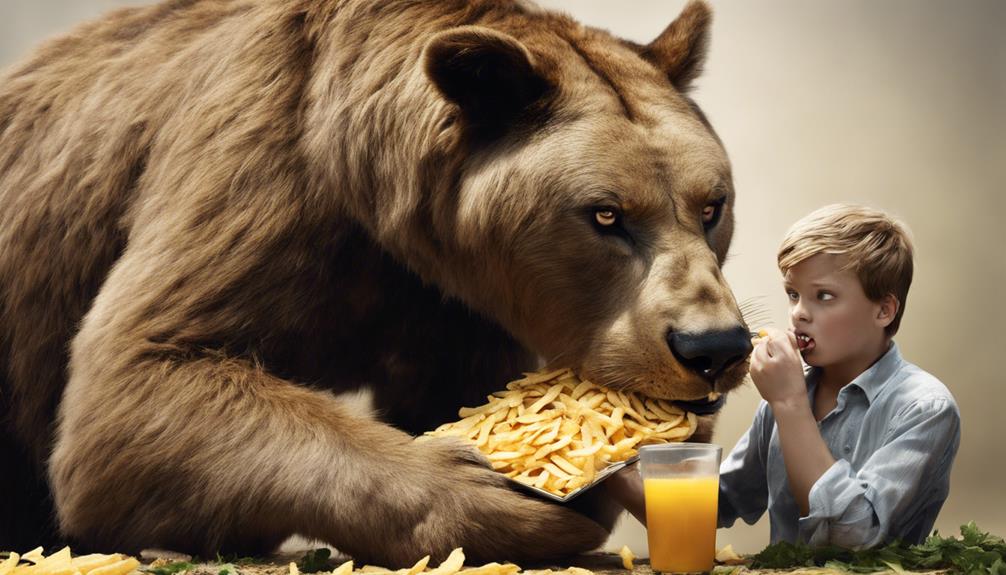
Let's debunk some common misconceptions about animals.
From chameleons changing colors for mood and communication to birds not abandoning their babies because of human touch, there's more to animal behaviors than meets the eye.
Goldfish have memories that extend beyond a few seconds, bats aren't blind, and bulls are provoked by movement, not just the color red.
Animal Communication Myths
Many people mistakenly believe that animals change color primarily to blend in with their surroundings, but the truth is much more complex. Chameleons change their color not just for camouflage, but also to communicate with other chameleons, regulate their body temperature, and display their emotions.
Animal communication involves a variety of signals such as vocalizations, body language, scents, and visual displays. For example, dogs communicate through barks, body posture, tail wagging, and facial expressions. Birds use calls, songs, and visual displays to communicate with each other and establish territories.
Animals have intricate communication systems that include warning signals, mating calls, and social interactions. Understanding these communication methods can give us a deeper insight into the fascinating world of animal behavior.
Animal Intelligence Misconceptions
Animals, often misunderstood in their capabilities, exhibit intelligence far beyond common misconceptions. Contrary to the belief that goldfish have a mere 3-second memory, they actually possess memories that last longer.
Dogs, often thought to see only in black and white, do have color vision and can perceive a range of colors. Chameleons don't change color to blend in with surroundings; instead, they alter their hue based on mood, temperature, and communication needs.
Birds can safely digest rice without the risk of exploding, dispelling the myth. Additionally, bats, often portrayed as blind, actually have specialized adaptations for hunting in darkness. These facts show that animals possess remarkable intelligence, proving that even Einstein failed to fully grasp the extent of their cognitive abilities.
Health Myths Unveiled

Dispelling common health myths can lead to a better understanding of how our bodies function. Let's explore some fascinating facts to uncover the truth behind prevalent misconceptions. Below is a table that highlights some intriguing health myths and the actual facts that debunk them:
| Health Myth | Fact |
|---|---|
| Milk increases mucus production | Scientifically proven false |
| Alcohol kills brain cells | Debunked by research findings |
| Caffeine dehydrates the body | Incorrect when consumed in moderation |
Understanding the reality behind these myths can empower us to make informed decisions about our health. Next, we will investigate more misconceptions related to historical inaccuracies. Stay tuned for the debunking of commonly believed historical myths.
Historical Inaccuracies Exposed

Historical inaccuracies can often distort our understanding of the past. Misrepresented events, factual errors, and revisionist accounts can all contribute to these misconceptions.
It's essential to critically examine historical narratives to uncover the truth behind these inaccuracies.
Misrepresented Events
Challenging common misconceptions, historical inaccuracies regarding notable figures like Napoleon are being exposed. The belief that Napoleon was unusually short is one of these misrepresented events.
Contrary to popular belief, Napoleon was actually of average height for his time, standing at 1.68m. This misconception likely arose from historical inaccuracies and has no factual basis. In reality, his height fell within the normal range for a Frenchman of his era.
The myth of Napoleon's short stature has been perpetuated by inaccurate information over the years. By uncovering these misrepresented events, we can gain a more accurate understanding of historical figures like Napoleon and dispel long-standing myths.
Factual Errors
Revealing factual errors in historical accounts is essential for gaining a more accurate understanding of the past. To explore some misconceptions that have been lost through the head, let's examine a comparison table of popular historical inaccuracies:
| Historical Error | Truth Revealed |
|---|---|
| Napoleon had a Napoleon complex | Napoleon was actually 1.68m tall, not short-tempered |
| Three wise men were kings | They were not kings, contrary to popular belief |
| Humans coexisted with dinosaurs | Dinosaurs and humans did not live together in history |
| Benjamin Franklin discovered electricity | Electricity was not discovered through a kite experiment |
| Ninjas wore black suits | Ninjas did not typically wear black suits as shown in media |
Revisionist Accounts
Revisiting historical inaccuracies can reshape our understanding of the past, shedding light on misconceptions that have persisted over time. When it comes to the notion that abandon babies were routinely left on church doorsteps in the past, historical research reveals a more nuanced reality. While instances of abandoning infants did occur, they weren't as prevalent as previously thought.
Scientific Misunderstandings Clarified

Understanding the complexities of human sensory systems beyond the traditional five senses is essential for dispelling common misconceptions in scientific knowledge. Our ability to sense body heat is one such example. While not often considered a traditional sense, the perception of temperature is vital for maintaining homeostasis and responding to environmental changes. Our skin contains thermoreceptors that detect heat and cold, sending signals to the brain for interpretation. This sensory input helps us avoid burns, regulate body temperature, and even experience the comforting warmth of a hug.
Furthermore, our capacity to sense temperature is intertwined with other senses, such as touch and pain. The intricate network of sensory neurons allows us to distinguish between gentle warmth, intense heat, and painful burns. By understanding the multifaceted nature of our sensory systems, we can appreciate the remarkable ways our bodies perceive and interact with the world around us.
Urban Legends Debunked

Urban legends often spread misinformation and misconceptions that can be easily debunked with factual evidence and critical thinking. Let's explore the world of debunking urban legends with the help of three wise facts.
| Urban Legend Debunked | Factual Evidence | Critical Thinking |
|---|---|---|
| Great Wall from Space | Multiple man-made objects visible from space, not just the Great Wall of China | Consider the vast size of Earth and the technology used to view it from space |
| Glass as Slow Liquid | Glass is an amorphous solid with a disordered atomic structure | Examine the scientific properties of glass and how it differs from liquids |
| Mother Birds Abandoning | Mother birds do not abandon their babies if touched by humans | Understand the natural instincts of birds and how they care for their young |
| Taste Bud Distribution | Taste buds are distributed evenly across the tongue | Experiment with different tastes on various parts of the tongue |
| Ancient Spherical Earth | Ancient civilizations, like the Greeks, knew the Earth was spherical | Research historical evidence and scientific knowledge from ancient times |
Mythbusting in Popular Culture

After exploring urban legends debunked, the focus now shifts to mythbusting in popular culture, shedding light on common misconceptions and truths in society. Popular TV shows like 'MythBusters' have played a significant role in bringing mythbusting into mainstream entertainment. These shows entertain while simultaneously educating viewers on the importance of separating fact from fiction.
Social media platforms and websites also contribute to spreading awareness about myths and truths, fostering a culture of critical thinking. By engaging in mythbusting activities, individuals of all ages can't only enjoy the process but also enhance their understanding of the world around them. It's vital to remember that mythbusting serves a dual purpose – not only does it entertain, but it also helps combat the spread of misinformation.
Embracing the principles of mythbusting can empower individuals to question what they hear and see, ultimately leading to a more informed and discerning society.
Debunked Everyday Myths

Swimming after eating doesn't cause cramps, contrary to popular belief; debunked everyday myths shed light on common misconceptions in society.
Let's explore another fascinating myth: the notion of left and right brain dominance. In the past, it was widely believed that individuals were either left-brained, analytical, and logical, or right-brained, creative, and intuitive. However, recent research has debunked this myth, revealing that both hemispheres of the brain work together in harmony for most tasks.
While certain functions may be more lateralized to one side, such as language processing being more dominant in the left hemisphere for most people, the idea of being distinctly left or right-brained is oversimplified. Our brains are incredibly complex, with intricate networks connecting various regions to perform tasks.
Understanding the true nature of brain function can help us appreciate the brain's versatility and adaptability, debunking the outdated myth of left and right brain dominance.
Frequently Asked Questions
Can a Fact Be Proven False?
Indeed, facts can be proven false. Evidence, research, and verified sources debunk inaccurate information. Critical thinking is vital to discern truth. Updating beliefs based on new evidence guarantees accuracy. It is imperative to challenge and verify information.
What Is an Example of a Myth and a Fact?
In cooking, a myth is that salt speeds up water boiling; in reality, it's a misconception. An example of a fact is that both sides of the brain can learn various skills, debunking the idea of strict divisions.
Did You Know Weird Facts?
Yes, I'm well-versed in weird facts! Birds using Xbox controllers and otters tricking birds with fish scales are fascinating examples. Learning about animals like owls, cats, and snakes always keeps me intrigued.
What Are Random Facts About Me?
I enjoy embracing heights of flavor in diverse cuisines, yet tremble at the thought of literal heights. My love for reading takes me on fantastical journeys, while Luna, my playful feline, keeps me grounded.
Conclusion
To sum up, remember to always question and investigate information before accepting it as true. By debunking common misconceptions and myths, we can expand our knowledge and understanding of the world around us.
Stay skeptical, seek out reliable sources, and don't be afraid to challenge popular beliefs. Keep learning and growing, and you'll be able to separate fact from fiction with ease.
Dana is our Lead Content Writer, bringing a wealth of knowledge and expertise to our team. With a background deeply rooted in animal studies and a profound love for all creatures, Dana is dedicated to crafting engaging and informative content that resonates with our audience. With Dana at the helm, you can trust that our content is accurate and engaging, catering to the diverse interests of animal enthusiasts everywhere.
Animals
Leopards Vs Wolves: 5 Key Differences
Traverse the contrasting worlds of leopards and wolves, uncovering intriguing divergences in habitat, size, behavior, and hunting techniques.

When comparing leopards and wolves, here are five key differences to note. Gray wolves roam North America, Europe, Asia, and a bit of Africa, while African leopards dwell in over 35 African countries. Wolves adapt to various environments such as tundra, forests, and deserts, while leopards navigate habitats from deserts to rainforests. Wolves stand taller and heavier compared to leopards, influencing power dynamics. Leopards display stealth and ambush in solitary hunting, while wolves rely on teamwork and communication within packs. These variations in habitat, size, speed, behavior, and hunting methods showcase their distinct survival strategies.
Key Takeaways
- Wolves are social animals, while leopards are solitary hunters.
- Wolves exhibit higher speeds (up to 65 km/h) compared to leopards (56-60 km/h).
- Leopards have a stronger bite force (500-600 psi) than wolves (400-661 psi).
- Wolves rely on teamwork for hunting, while leopards use stealth and ambush tactics.
- Size-wise, male leopards are heavier (up to 91 kg) than male wolves (around 40 kg).
Habitat Range and Distribution
Among the key differences between leopards and wolves lies their distinct habitat range and distribution across various continents. Gray wolves, known for their adaptability, can be found in North America, Europe, Asia, and a small part of Africa. In contrast, African leopards are native to over 35 African countries.
Wolves thrive in diverse ecosystems such as arctic tundra, forests, prairies, grasslands, and deserts. On the other hand, leopards exhibit remarkable versatility, inhabiting habitats ranging from deserts to rainforests in Africa. The adaptability of leopards to a wide range of environments showcases their unique survival skills.
Despite the global distribution of grey wolves, the more regionally specific habitat of African leopards highlights their ability to thrive in varying conditions. Understanding these habitat differences is essential in appreciating the distinct ways in which a leopard would navigate its surroundings compared to grey wolves.
Size and Weight Discrepancies
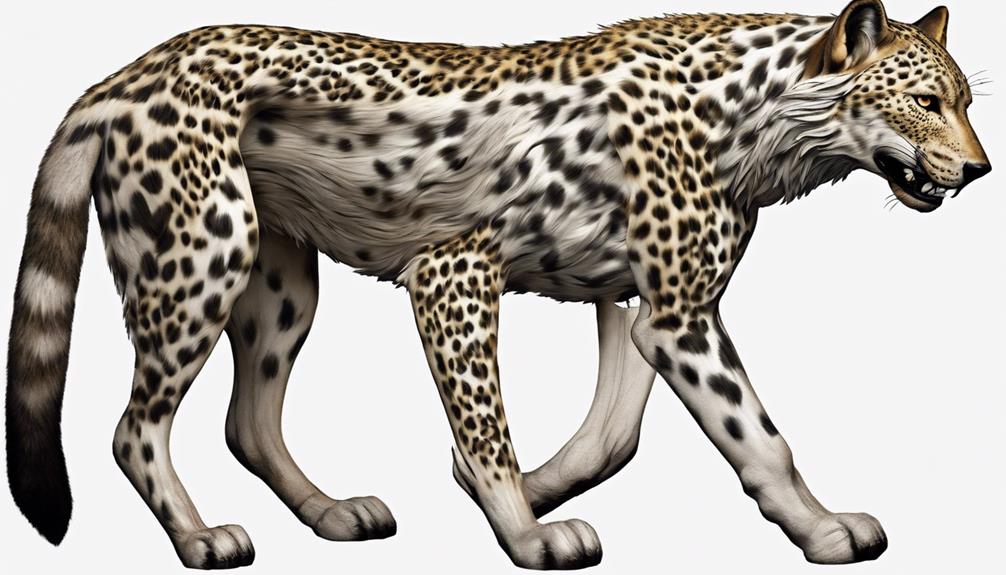
Comparing the size and weight differences between leopards and wolves reveals significant disparities that can influence the dynamics of their interactions. When looking at these measurements, it becomes clear that leopards are generally heavier than grey wolves. Male leopards typically weigh around 60 kg, while male wolves weigh approximately 40 kg.
Additionally, the average length of a male leopard ranges from 3 to 6.2 feet, whereas a grey wolf can reach up to 6.6 feet in length. Regarding height, wolves stand taller at 2.4 feet compared to leopards at 2.2 feet at the shoulder.
It's interesting to note that leopards have been recorded at higher weights, with the heaviest male reaching a whopping 91 kg, surpassing the average weight of a wolf. These size and weight differences can be vital in understanding the power dynamics between these big cats and wolves.
Speed and Agility Variances

Speed and agility play pivotal roles in shaping the dynamics between wolves and leopards during their interactions in the wild. When it comes to a chase, wolves have the upper hand with speeds reaching up to 65 km/h, surpassing the African leopard's top speed of 56-60 km/h. This speed advantage gives wolves the edge in quick pursuits, especially when compared to leopards, who are slower than cheetahs and lions.
In a confrontation, the higher top speed of wolves becomes a critical factor, potentially influencing the outcome between a wolf vs. one of the leopards. Additionally, wolves' agility shines as they can swiftly maneuver through various terrains, contrasting with the slightly slower movements of leopards. Understanding these speed and agility variances is essential as they've a significant impact on the hunting and fighting strategies of both wolves and leopards in the wild.
Intelligence and Social Behaviors
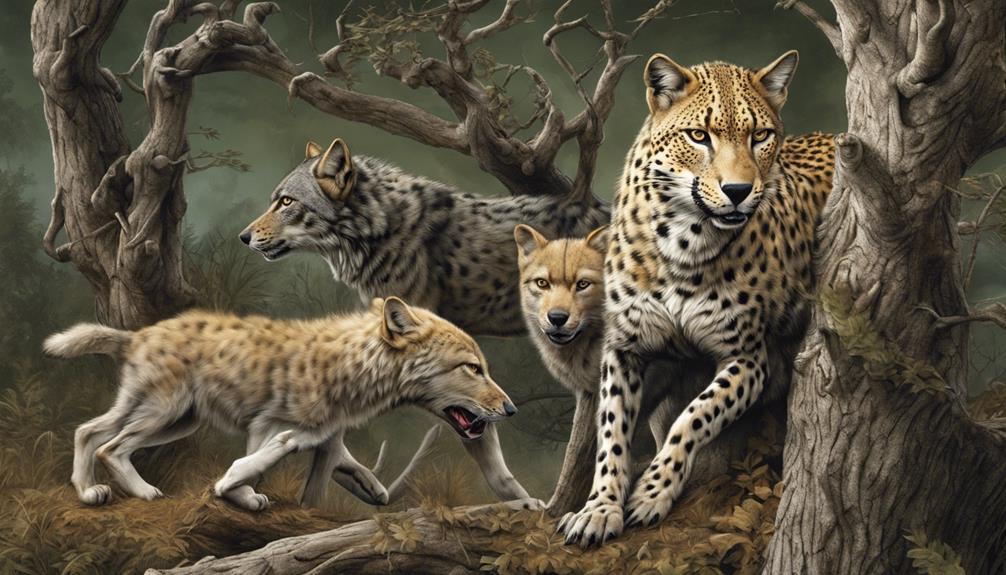
In understanding the dynamics between wolves and leopards, their differing levels of intelligence and social behaviors play a crucial role in shaping their respective interactions in the wild.
Wolves are renowned for their high intelligence, which is reflected in their ability to form complex social structures within their packs. They communicate through various vocalizations, body language, and scent marking, all of which contribute to maintaining pack cohesion and successful hunting strategies.
On the other hand, while leopards are intelligent in their own right, they don't exhibit the same level of complex social behaviors as wolves. Leopards are solitary creatures, preferring to hunt and live independently without the need for social interactions.
This contrast in social dynamics highlights the teamwork and cooperation essential for wolves' survival, in contrast to the self-reliant and solitary nature of leopards. The way these animals interact and communicate with each other greatly influences their hunting techniques and overall success in the wild.
Bite Force and Hunting Techniques
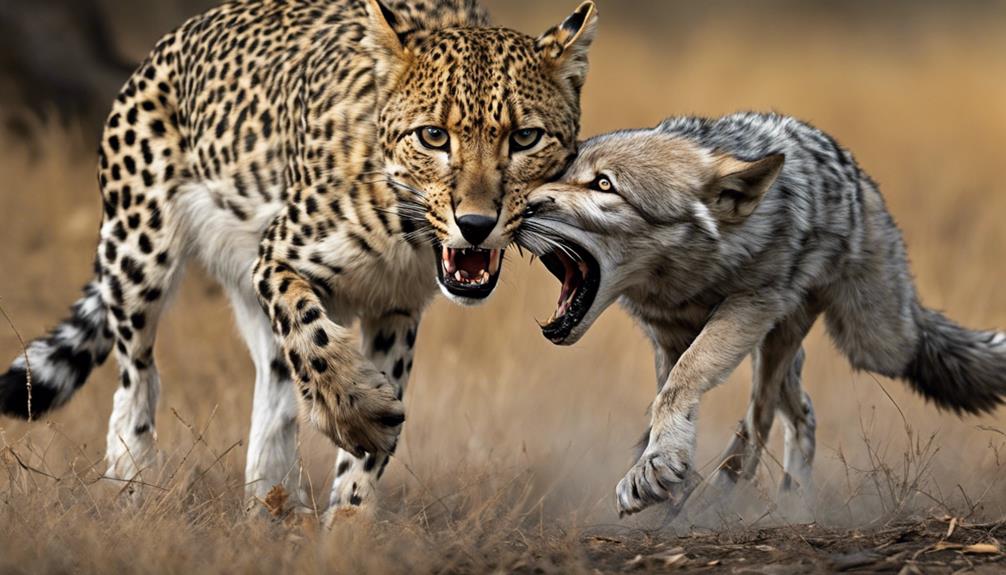
While the intelligence and social behaviors of wolves and leopards set them apart, a significant distinction can be found in their respective bite forces and hunting techniques.
- Wolves, with a bite force ranging from 400-661 psi, rely on this strength for gripping and tearing prey during hunts.
- Leopards, on the other hand, possess a bite force of 500-600 psi and use their powerful jaws to deliver a suffocating bite, often targeting the throat.
- Wolves showcase cooperative hunting tactics, working together to take down larger prey efficiently.
- In contrast, leopards are solitary hunters, employing stealth and ambush techniques to catch their prey effectively.
The differences in bite force and hunting techniques between wolves and leopards highlight the unique strategies each species has evolved to survive in their respective habitats. Wolves' cooperative efforts allow them to tackle larger prey, while leopards' solitary nature emphasizes stealth and precision in their hunting methods. This diversity in approach showcases the adaptability and resourcefulness of these apex predators.
Frequently Asked Questions
What Is the Difference Between a Snow Leopard and a Wolf?
The key difference between a snow leopard and a wolf is their hunting style. Snow leopards are stealthy, solitary hunters, while wolves are social pack animals that hunt cooperatively. Each species has its unique strategy for survival.
Are Leopards Stronger Than Wolves?
Yes, leopards are stronger than wolves when it comes to individual power. Leopards possess greater strength and agility, giving them an advantage in one-on-one encounters. Wolves rely on teamwork and numbers to compensate for their lesser individual strength when facing leopards.
Is Wolf Better Than Leopard?
I'd say the wolf's cunning and pack mentality make it more adaptable and strategic, but the leopard's agility and stealth give it a unique advantage. Both are formidable in their own right, each excelling in different aspects.
Who Would Win a Wolf or Clouded Leopard?
In a face-off between a wolf and a clouded leopard, the agile leopard's stealth and speed could outmaneuver the wolf's strength. But teamwork might give the wolf an edge. It's a battle of wits and tactics.
Conclusion
To sum up, when it comes to comparing leopards and wolves, it's evident that leopards reign supreme in every aspect. From their vast habitat range to their unmatched speed and agility, leopards outshine wolves in every way.
Their intelligence and social behaviors set them apart, not to mention their powerful bite force and hunting techniques. In the battle of leopards vs wolves, the leopard emerges as the ultimate predator of the wild.
Dana is our Lead Content Writer, bringing a wealth of knowledge and expertise to our team. With a background deeply rooted in animal studies and a profound love for all creatures, Dana is dedicated to crafting engaging and informative content that resonates with our audience. With Dana at the helm, you can trust that our content is accurate and engaging, catering to the diverse interests of animal enthusiasts everywhere.
-

 Vetted2 months ago
Vetted2 months ago15 Best Cat Foods for Managing Hyperthyroidism – Vet Approved and Feline Friendly
-

 Animal Facts2 months ago
Animal Facts2 months agoSpring Animals: A Guide to Seasonal Wildlife
-

 Cats7 months ago
Cats7 months agoTop 5 Cat Breeders in Arkansas: A Guide
-

 Vetted1 month ago
Vetted1 month ago15 Best Dog Foods for Kidney Disease – Expert Recommendations for Your Pet's Health
-

 Vetted2 months ago
Vetted2 months ago15 Best Fresh Dog Food Delivery Services for Your Pup's Health and Happiness
-

 Rabbits2 months ago
Rabbits2 months agoExploring Rabbit Holes: What Do They Look Like?
-

 Pets2 months ago
Pets2 months agoLatest Pet Statistics in US – Trends & Insights in 2024
-

 Fish2 months ago
Fish2 months agoKeeping Your Sucker Fish Thriving at Home






















